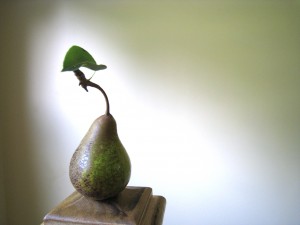Uncategorized

I went pear picking this morning (for the first time ever). It was well worth the early rise on this last day of real summer. The pick was organized by the Halton Fruit Tree Project, a volunteer-based group that picks excess fruit from private property in the area, and then donates it to local food banks. And of course the volunteers get a cut too.
Similar organizations exist all over:
St. John’s Fruit Tree Project by Root Cellars Rock!, St. John’s
urban Orchard by reachAbility, Halifax
Les Fruits Défendus, by Santropol roulant, Montreal,
Hidden Harvest Ottawa
Not Far From the Tree, Toronto
Mississauga Fruit Tree
Hamilton Fruit Tree Project
The Appleseed Collective, Guelph
Out of Your Tree, Saskatoon (winner of the Best Name Award)
Calgary Urban Harvest Project
Operation Fruit Rescue Edmonton
Vancouver Fruit Tree Project
The Sharing Farm Society, Richmond
Lifecycles Fruit Tree Project, Victoria
And that’s just for Canada, for all 7 of us.
I love the whole idea. It’s so simple – and makes sense. If you love local, I seriously suggest you jump on this bandwagon, because it’s actually more like a fun hayride.
Not only does so-called excess food not go to waste (by simply rotting untouched on the ground), it becomes available to people in your community who may not normally have access to fresh fruit, in season, at the height of ripeness and peak of deliciousness. On top of that, you can meet some like-minded people in your area and take home a sweet cut of the bounty.
I am no Martha Stewart, but I am stoked about what to make with these pears—a pie maybe, or compote? Or shall I branch out and try a pear chutney? Ding! That’s the winner.
This morning was a great way to end summer – and I am psyched that the Halton Fruit Tree Project has a few more picks left in its season. Count me in.
I’m impressed with Toronto; it has shown heart.
It had felt like things were getting a bit chilly in this town over the summer. City Hall’s swing to the right and its attempts to drop Toronto’s local food procurement policy, remove funding from community gardens – essentially putting an end to a growing urban agriculture movement, reversing bike lanes that even the cabbies like, closing community swimming pools and public libraries — basically all things that build community and make big cities livable.
But I think a very clear message has been sent to the powers that be over the last week—and we have Jack Layton to thank for it — amongst all the other things we have to thank him.
In his passing, we have rallied and stood up proudly, and shown just what kind of leaders we want. I am very proud of Torontonians. They — we — have shown heart, something we are often accused of lacking.
It is events like this, sad as they are, that can help build the character of a city — a united identity and vision of what a location represents.
I’m feeling optimistic.
Thanks Jack, you managed to bring us all together once again!
Winterlicious is upon us once again, in case you hadn’t seen the many ads around town. It’s running between January 28 to February 10, and reservations for the prix fixe treats are now being taken.
The lunch menus are running at $15, $20 or $25, and dinner menus are at $25, $30, or $35. These all include starter (or appetizer, as I like to say), entrée (or main course — never understood why the French word for “appetizer” has somehow become “main course”, anyone?), and dessert.
Drinks, taxes and tip are additional.
The City of Toronto site has a handy restaurant list where you can sort restos by various criteria, including Price, type of Cuisine, and Neighbourhood. And I’m very excited to say that one of the Cuisine criteria is Local/ Fresh Market.
Hooray!
Now exactly which restos are truly Local and which are Fresh Market is hard to tell. I’m thinking we at LocalFoody may have a good opportunity here to broaden our database.
All that said, LFP is promoting three of its certified local restaurants:
Reds Bistro
Veritas
Auberge du pommier
Bon appétit!
Eating local is akin to eating seasonally, and the benefits are widespread for the eater, the economy and the environment. Most of the time, eating seasonally is also a lot of fun, you get to discover new foods and learn new ways to prepare them. But what are we supposed to do in the middle of winter?
Eating local in winter often means eating the foods that were picked and sometimes preserved in autumn, at the end of the last harvest. Look at the foods your grandmother (or great-grandmother, depending on your age) would have prepared: soups, stews, breads, meat (for meat-eaters), root vegetables, fruits, pulses, pasta, grains.
Thanks to the wonders of the greenhouse and winter farming, we do have access to delicious local food in winter.
Here is a list of locally available foods. It is by no means exhaustive, but I want to show that while our choices are more limited this time of year, we still have some decent options.
Vegetables: Beets, carrots, cabbage, celeriac root, garlic, Jerusalem artichokes, red kale, leeks, button mushrooms, crimini mushrooms, Portobello, shitake, red and yellow onions, parsnip (everyone’s fave!), fingerling potatoes, rutabaga, acorn squash, butternut squash, pumpkin, spaghetti squash, turnip, sweet potatoes.
(Thank you Pfennings, for listing where your food comes from on your website)
Fruit: apples, pears, dried fruits — like apricots, raisins, prunes, cherries, apple, certain berries, etc.
Grains and pulses: wheat, spelt, oats, barley, rice, millet, amaranth, quinoa, flax, corn, buckwheat, hemp, beans (pinto, kidney, navy beans, black), lentils (red, green), split peas (green, yellow).
Animal foods: milk, eggs, yogurt, kefir, cheese, beef, chicken, duck, pork, turkey.
Seeds: sunflower, pumpkin, sesame.
(Thank you Grassroots Organics for listing your bounty)
If you aren’t always able to find local foods, don’t fret. Take a minute to think about your reasons for choosing local in the first place, and apply these same principles to the foods that are available. If you’re concerned about nutrition or the environment, opt for the foods that meet your criteria ( organic, sustainable, fair trade, etc.).
In the meantime, as we wait patiently for those first cherries to appear, we can become soup and stew experts. Here are a couple yummy winter recipes to help get you started:
Epicurious – Celery Root and Potato Puree with Roasted Jerusalem Artichoke “Croutons”
101Cookbooks – Lively up yourself lentil soup
I’m pretty excited for this event:
Join us for a special Toronto screening of The Economics of Happiness at the William Doo Auditorium, New College, University of Toronto. The film will be preceded by a reception and exhibit of artwork by Sheridan College students entitled ‘Animating Good Food Ideas’. It will be followed by a panel discussion with producer Helena Norberg-Hodge, activist chef Joshna Maharaj and urban farmer Eric Rosenkrantz, moderated by author Wayne Roberts.
when: 5:30 pm – 9:00/9:30 pm, Monday, January 24th
5:30 – 7:00 pm – Animating Good Food Ideas, Exhibit and Reception
7:00 – Introduction to the film and screening
8:30 – Panel discussion
where: William Doo Auditorium, New College, University of Toronto; 45 Willcocks Street, in the basement of the New College Residence (Enter the William Doo Auditorium through the door at the Southeast corner of Willcocks Street & Spadina Avenue).
organizational partners: Sustain Ontario; New College (University of Toronto); Equity Studies (New College, University of Toronto); Office of Residence and Student Life (New College, University of Toronto); Hart House (University of Toronto); Hart House Social Justice Committee; FoodShare Toronto; Local Food Plus; Toronto Food Policy Council; The Stop Community Food Centre; Meal Exchange; and Sheridan College.
*** update: This event is free!
What’s most important to you when looking for organic and local food? What would you love to be able to find that you can’t? How do you decide where to shop or what restaurants to eat at? How can LocalFoody help you solve those problems? Please share your thoughts in the comments.
Thanks!
Welcome to the LocalFoody Blog.
